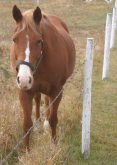The Holstein-Wagyu cross produces ‘intense marbling’ that this Saskatchewan family hopes will appeal to consumers
CARONPORT, Sask. — What do you get when you cross a Holstein heifer with a Wagyu bull?
The answer is Saskatchewan Snow Beef, and it’s no joke.
Ian and Nicole Crosbie are marketing the beef produced on their farm just north of the Trans-Canada Highway west of Caronport, Sask.
They also own Benbie Holsteins with Ian’s parents, Neil and BJ. The farm was established by Ian’s great-grandfather after the Second World War and has since been family owned and operated. Ian and Nicole bought into the operation in 2012.
Read Also

Beef check-off collection system aligns across the country
A single and aligned check-off collection system based on where producers live makes the system equal said Chad Ross, Saskatchewan Cattle Association chair.
There, they milk 150 Holsteins three times a day with the help of family and employees.
“We try and be fairly progressive,” said Ian. “We genomic test all of our Holstein offspring and breed replacement females from the best genetics we have.”
But supply management dictates that the dairy doesn’t need all its heifer calves.
Cross-breeding Holsteins with beef semen isn’t new but when Ian had a $75, six-ounce Angus-Wagyu steak four years ago in Toronto, he got to thinking.
He bought fullblood semen from Wagyu Sekai in Ontario and began an artificial insemination program.
In pens across the road from the dairy, the crosses stand out in colour — black rather than the black-and-white Holstein — and shape — more Holstein than beef animal.
The calves are born at between 60 and 70 pounds and are raised with the Holstein dairy calves until they are 18 months old. They then go to finishing pens.
Crosbie said the cross is extremely slow to mature, unlike the typical feedlot animal, and needs 28 to 30 months to produce the right meat.
That meat is flecked with the fat characteristically found in Wagyu cuts.
“The name snow beef is a metaphor for the intense marbling that goes through the beef,” Crosbie said. “It looks like it’s snowing through your beef.”
Consumers who don’t understand marbling may be put off by the amount of white in the beef but Crosbie said savvy consumers know they will be getting tender meat.
Wagyu beef is considered extremely healthy and high in unsaturated fat.
“Fat’s back in,” he said. “Look at the demand for butter and cream in the last five years.”
The Crosbies launched Saskatchewan Snow Beef last summer and sell some at the Moose Jaw Farmer’s Market. They slaughter about one animal a month at West Bridgeford Meats in Tugaske, Sask.
Little Red Market Café in Mortlach, Sask., had snow beef sliders on the menu for a while.
In mid-September, The Capitol and Lancaster Tap House in Regina began offering snow beef on their menus. The restaurants bought entire carcasses and developed menu items for a farm-to-table promotion
Crosbie is optimistic that once consumers get a taste of the tender beef, even though they will pay more for it, they will buy it again.
The worst-case scenario is his family having full freezers, he said.
But he believes the known quality of Wagyu beef, the ability to trace the food back to the farm and the desire to buy local will sell the meat in Saskatchewan and eventually beyond.
“I could turn it into an extremely scalable business and still get consistency and quality,” he said.
“The Holsteins add frame and scale, while the Wagyu provide the loin, extreme beefiness and efficiency at producing beef on their own.”
Crosbie added that he would like to see data collected on the Holstein role in beef production. The dairy sector is well organized and known for its records and he said it wouldn’t take much more to add beef traits into the mix.
“We know Holstein beef marbles well, we just have no data,” he said.
The Crosbies use Facebook and Instagram to promote their beef. Ian said they plan to continue the snow beef program as a way to add value to heifers and their operation’s bottom line.


















